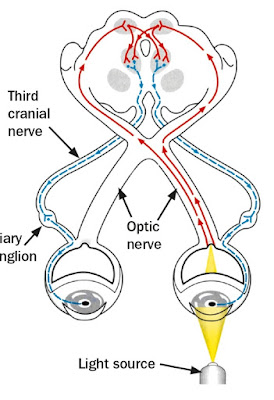RAPD Specific conditions during swinging light test
Hippus
Normal pupils, particularly those of young people, sometimes show slight fluctuation in size (of less than 1 mm) even when the light shining into the eye is constant. This is called hippus and it can make eliciting a RAPD more difficult.
Non-reactive pupils
A RAPD can still be detected even if one pupil cannot change size (i.e. it is fixed), because of trauma, posterior synechiae or because dilating or constricting eye drops have been used. Having established that the pupil of one eye does not change size, regardless of which eye has the light shone into it, concentrate on the eye where the pupil is reactive.
Note what happens to the reacting pupil when the light is shone into each eye in turn. shows what happens when the eye with the afferent pathway defect is also the eye with the fixed pupil.
If the (more) normal eye is the one with the fixed pupil then, as the light moves from this eye to the other eye, the reacting pupil will dilate.
OPTOMETRY-SHARP VISION
Optometrist

